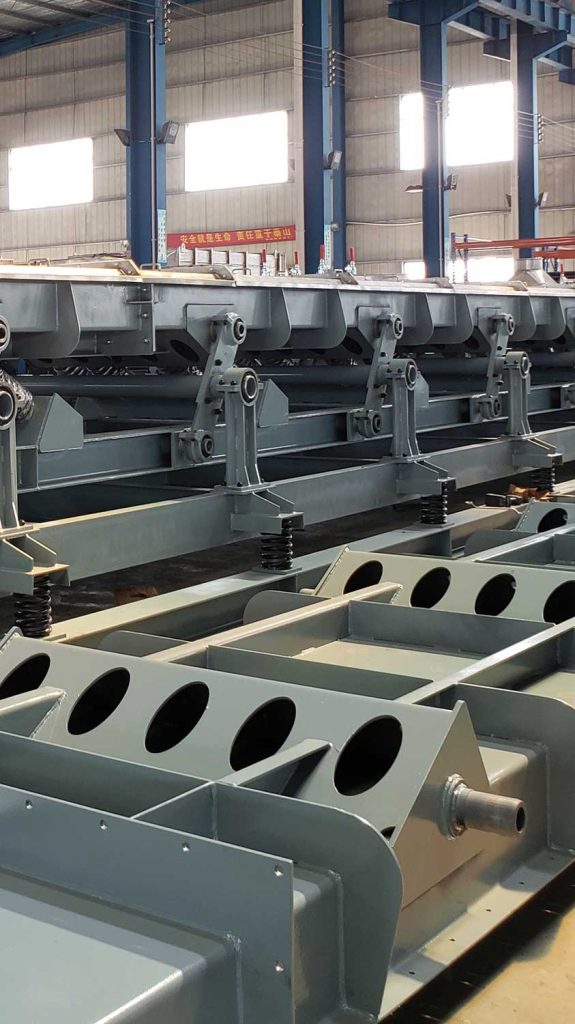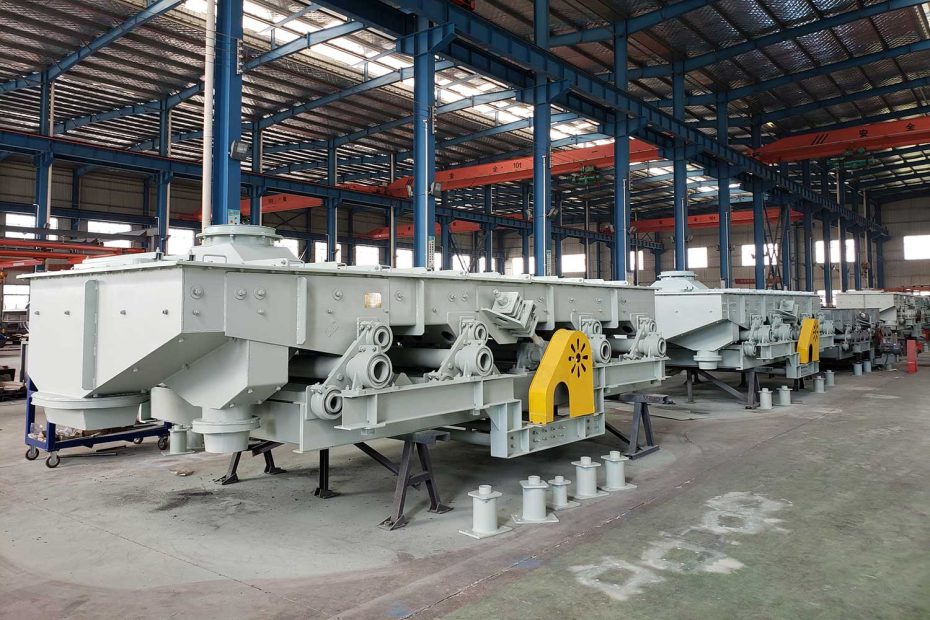What is a Vibrating Conveyor?
The vibratory conveyors are part of numerous processes such as transport, vibrating conveyors are commonly employed in industry to carry a wide variety of particulate and granular types of bulk materials. The fundamental action of the vibrating troughs on the bulk material loaded on it is to throw the particles upward in the forward direction so that the material performs a series of short hopping movements and propagates at a certain speed.
Vibrating conveyors are robust conveying equipment used for fine to coarse-grained bulk materials. Whether this is powdery materials, gravel, or coarse screen. They are extremely durable provided that these materials are conveyed horizontally. The only limitation results from the suspension design.
Features of the Vibrating Conveyor?
High conveying rates are demonstrated particularly when compared directly to conveyor belts, which block with the same material pressure or wear out too quickly when used in the silo.
However, vibrating conveyors are relatively impervious to congestion or conveyor channel blockages. They generally work freely again without intervention.
It should be noted when planning the design that they work most efficiently in a horizontal or inclined direction.
An important characteristic of a vibrating conveyor is the ease with which the flow rate of the conveyed material can be controlled by adjusting the amplitude and or frequency of the vibration. This particular aspect of such conveyor has led to the widespread application of vibrating troughs as feeders employed to supply material in controlled amounts to various machines. When the trough is replaced by a screen, the vibratory conveyor may serve as a vibrating screen, which has wide application in various industries.
Work principle
The vibrating conveyor moves upwards at a sinusoidal angle in the direction of transport. With each forward feed, it lifts the material depending on the cast parameter and pushes it in the desired direction. During reverse, the material remains motionless due to its inertia and the downwards direction of the conveyor.
With every additional forward vibration, the material is inched continually forwards. This process is repeated depending on the frequency of the vibratory drive. The speed of the material feed is determined by the amplitude range and the frequency of the conveyor’s vibrations.
Two types of vibrating conveyors
According to the vibration drive source: Vibrating Conveyors with unbalanced drive and Vibrating Conveyors with magnetic drive. The unbalanced drive vibrating conveyors can be divided into elastic link type and inertial type. The elastic link type vibrating conveyors according to the number of vibration components can be divided into three types: single mass, double mass, and three mass type.
- Magnetic vibrating conveyor: It consists of an iron core, coil, armature, and trough. When the rectified current passes through the coil, a periodically changing electromagnetic suction force is generated, which arouses the vibration of the trough. Generally, high frequency and small amplitude are used.
- Unbalanced vibrating conveyor: The unbalanced vibrating conveyors adopt a vibrating motor as a high-quality vibration source, so that the material is thrown up and moves forward to achieve the purpose of conveying; the structure is divided into open type and closed type; the conveying form can be trough conveying or pipe conveying, motor Positions can be top, bottom or side mounted.
- Elastic link type vibrating conveyor: The elastic link type vibrating conveyor is composed of an eccentric shaft, connecting rod, connecting rod end spring, and material trough. The rotation of the eccentric shaft causes the end of the connecting rod to reciprocate, causing the trough to vibrate in a directional manner. Promote the material in the tank to move forward continuously. Generally, low frequency, large amplitude or medium frequency, and medium amplitude are used.
- Single-mass body vibrating conveyor: For the single-mass body vibrating conveyor, only the conveying trough generates vibration, so the vibration force is transmitted to the foundation, and most of them are light;
- Double-mass body and the three-mass body vibrating conveyor: for the double-mass body vibrating conveyor and the three-mass type body vibrating conveyor, in addition to the conveying trough, there are also counterweight frames participating in the vibration. The structure is slightly complicated, but it can be basically The vibration force to the foundation is eliminated, and the resonance principle can also be used to minimize the required excitation force.
- Inertial vibrating conveyor: The inertial vibrating conveyor is composed of an eccentric block, main shaft, trough, etc. The centrifugal inertia force generated when the eccentric block rotates causes the trough to vibrate. Medium frequencies and amplitudes are generally used.
- Elastic link type vibrating conveyor: The elastic link type vibrating conveyor is composed of an eccentric shaft, connecting rod, connecting rod end spring, and material trough. The rotation of the eccentric shaft causes the end of the connecting rod to reciprocate, causing the trough to vibrate in a directional manner. Promote the material in the tank to move forward continuously. Generally, low frequency, large amplitude or medium frequency, and medium amplitude are used.
Load Capacity
Get what the conveyor will move, and how much should be moved, and at what speed to determine the ideal burden limit and pieces each moment. These qualities will give your provider a smart thought of the overall size, shape, and obligation rating of the right conveyor.
Applications

Basically, vibratory conveyors can be used to transport all granular, lumpy, and non-sticky materials that are dry and not prone to caking or sticking. Generally, bulk solids with a size range from 0.5 mm to 1200 mm can be easily conveyed and fed with these units. Vibratory conveyors are used in environmental engineering, e. g. in glass processing/recycling, in the timber industry, in waste recycling, waste processing, and scrap recycling.
In the primary industries, vibratory conveyors are used for transporting construction site waste, in mining, in ore beneficiation, in the non-metallic minerals industry as well as in the cement, lime, and gypsum industries. In the processing industries, the machines are used in the chemicals, fertilizer, animal feed, plastics, and foodstuffs industries. Other applications for vibratory conveyors are in the foundry and metallurgical industries. There they are used in foundries of all types, smelting works, small-scale iron working, dross processing, surface engineering, and steel mills.
- Screening Applications and Fluidizing Products.
- Classification of Products by size for either drying or Cooling Applications.
- The Conveyor can be used for Promoting leveling in Product Packing Vessels.
- Elevating products between process points.
- Spreading products for uniform distribution transfer applications from different-sized process outlets to downstream inlets.
- Removing excess moisture from products or just general point-to-point conveying.
- Transporting food grains or ingredients to the product line
- Conveying powders and chemicals between processes and equipment
- Removing foundry sands from beneath shakeouts
- Conveying chipping, shredding, and recycled materials
Benefit
- Possibility of conveying materials up to 45 m
- Vibrating conveyor unit widths from 6 inches to 10 feet, and lengths up to 400 feet
- Heavy duty vibrating conveyor designs feature rugged coil spring construction with rocker arm stabilizers
- Gentle handling of fragile products
- The capacity of conveying different kinds of materials without having them mixed
- High-temperature conveyors available for handling materials up to 2000 deg Fahrenheit
- Possibility of performing different processes besides conveying such as classification of products, heating, cooling, de-watering, etc.
- The possibility of automating processes to extract the product previously conveyed in different points of the equipment
- Natural frequency design for low stresses and long life
- Continuous structural steel base along the length of the conveyor
- Few moving parts, easily cleanable surfaces, minimum maintenance
- Balanced / Isolated units allow mounting in the upper structure due to reduced reactions
- Polished trough and special coatings available for sticky products
- Easily replaceable liners and wear surfaces are available
- Dust tight construction for safety and comfort available
- Manual or automatic bypass gates are available
- Leak-proof troughs eliminate spillage
- Quiet operation, low operating costs, energy efficient
Works Cited
- “Vibration for clean conveying”, AT minerals, Visited 12 Aug,https://www.at-minerals.com/en/artikel/at_2010-05_Vibration_for_clean_conveying_913550.html
- “Vibrating conveyors”, Schenck Process Holding GmbH, Visited 12 Aug, https://www.schenckprocess.com/glossary/vibrating-conveyors
- “Vibratory Conveyor”, Kiron Food Processing Technologies LLP, Visited 12 Aug, https://www.fptindia.com/blog/vibratory-conveyor
